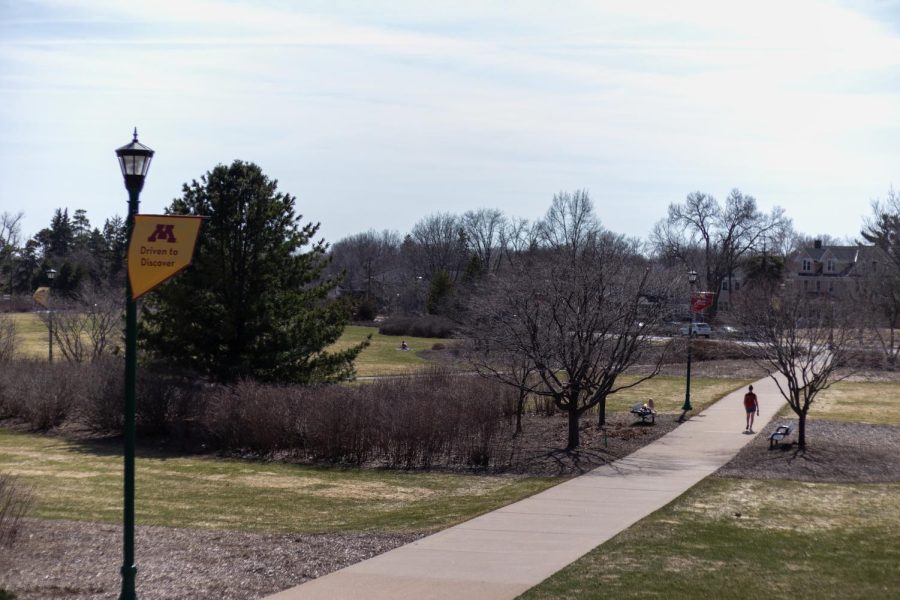As the weather warms up and the first signs of plant life emerge, the University of Minnesota’s Facilities Management (FM) is making sure outdoor spaces are prepared for spring.
FM clears away the remnants of winter and brings in new equipment and plants for the spring, having to adapt to all four of Minnesota’s seasons.
A common springtime task for FM landscape workers is removing the sand, litter and organic debris exposed after the snow melts, according to Tom Ritzer, assistant director of landcare. FM workers clean up the campus and the state fairgrounds, where the University brings excess snow from campus during the winter.
FM also has to clean, organize and prepare tools and equipment for summer, Ritzer said. Some equipment has different uses across seasons, such as lawn mowers, which must be reverted from their winter use as snow removal machines.
Landscaping workers also spend this time preparing the flower beds and seasonal displays, according to Ritzer. They clear out any dead plant material and will begin planting bulbs and pansies later this month.
FM also puts out lawn furniture so students can sit outside and enjoy the warmer weather, Ritzer said.

According to Ritzer, FM street sweeps throughout the growing season, about April through October, to keep the campus clean and to help prevent debris from getting into rivers or other bodies of water.
In mid-May, FM will activate the irrigation system and repair any issues it has, Ritzer added. This is also when events at the University during which FM often does litter control, tend to become more frequent.
Long-term projects aim to increase biodiversity
Some long-term projects FM is working on include increasing biodiversity in trees and converting traditional campus landscaping to low-input landscaping, Ritzer said.
According to Ritzer, having biodiverse trees prevents one disease or insect from wiping out all of the trees in an area, which happened across the Midwest in places that primarily planted ash trees in the early 2000s when the emerald ash borer, an invasive species of beetle, infested and destroyed millions of ash trees.
FM is also phasing in tree species believed to be more resilient to warmer weather caused by climate change, Ritzer said.
Over the past decade, FM has been working to convert traditional landscaping to low-input landscaping such as meadows and prairies, Ritzer said. Low-input landscapes require less maintenance and use less equipment, fertilizer and potable water than traditional landscaping.
Preparing indoor spaces for summer temps takes weeks
In addition to adapting the outdoor spaces to the changing of the seasons, FM is also responsible for preparing University buildings for weather changes, including when temperatures rise in the spring and summer.
According to FM Associate Vice President Bill Paulus, FM transitions buildings from heating to cooling, which unlike in most homes, is an involved process that takes several weeks.
“The process includes filling and preparing cooling towers and varies slightly in each of the 280 campus buildings we serve, and can only be completed when temperatures are consistently above freezing,” Paulus said in an email to the Minnesota Daily. “Additionally, some of our buildings use window air conditioning units, which are started-up on an individual basis.”
The challenge of the seasons
Working in a climate that experiences a wide range of temperatures adds complications to landscape architecture, Brad Agee, the director of Undergraduate Studies for the Department of Landscape Architecture, said.
The freeze-thaw cycle causes cracks in pavement to form and grow quickly, “essentially guaranteeing” concrete will crack, Agee said.
Additionally, many decorative plants used by the University such as begonias, which are native to South Africa, are not suited to Minnesota winters, Agee said. In warmer climates, begonias are perennial, but in Minnesota they must be dug up and replanted every year.
Agee said there are plants native to Minnesota that are better suited for the range of seasons. Many of the tall grasses in the prairies and meadows are native to the region, which is part of what makes these areas low-input.
According to Agee, deciding what to prune before the winter months can also be difficult because some plant material is used by wildlife to withstand the winter. He gave the example of matted down ornamental grasses, which act as a blanket for pollinators trying to withstand the cold.















